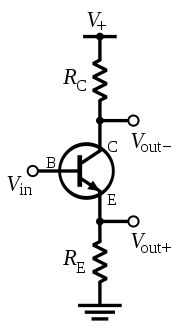
Phase splitter
Encyclopedia

The term is most often applied to amplifiers that produce two "balanced" voltage outputs: of equal amplitude but opposite polarity (i.e. 180 degrees phase difference), but sometimes is used to refer to the generation of quadrature
Quadrature
Quadrature may refer to:In signal processing:*Quadrature amplitude modulation , a modulation method of using both an carrier wave and a 'quadrature' carrier wave that is 90° out of phase with the main, or in-phase, carrier...
signals (i.e. differing by 90 degrees). The term is not used for logic circuits producing complementary outputs, nor applied to differential amplifier
Differential amplifier
A differential amplifier is a type of electronic amplifier that amplifies the difference between two voltages but does not amplify the particular voltages.- Theory :Many electronic devices use differential amplifiers internally....
s that have balanced inputs and outputs.
Methods
- using a unity gain inverting amplifier to provide an inverted copy of its input signal;
- a split-load amplifier (also known as "concertina phase splitter"); a transistorTransistorA transistor is a semiconductor device used to amplify and switch electronic signals and power. It is composed of a semiconductor material with at least three terminals for connection to an external circuit. A voltage or current applied to one pair of the transistor's terminals changes the current...
implementation is shown in the diagram; - a differential pair amplifierDifferential amplifierA differential amplifier is a type of electronic amplifier that amplifies the difference between two voltages but does not amplify the particular voltages.- Theory :Many electronic devices use differential amplifiers internally....
can form a phase splitter in two ways:- if the shared emitter (or cathode or source, for triodeTriodeA triode is an electronic amplification device having three active electrodes. The term most commonly applies to a vacuum tube with three elements: the filament or cathode, the grid, and the plate or anode. The triode vacuum tube was the first electronic amplification device...
s or FETFetFet is a municipality in Akershus county, Norway. It is part of the Romerike traditional region. The administrative centre of the municipality is the village of Fetsund.Fet was established as a municipality on 1 January 1838...
s) connection is fed from something approximating a constant current sink (for example, a relatively large value resistor with a significant voltage drop, i.e. a long-tailed pair) then only one input (base, grid or gate) need be driven with signal; the shared connection will vary in voltage with half the amplitude of the input, becoming an input to the second device (which acts as a common-base, or common-grid/gate amplifier). The sum of the currents in each of the collectors (or anodes or drains) will be almost constant, hence an increase in one will be matched by an equal decrease in the other, giving rise to equal, but opposite phase, voltages on the outputs. - if the shared emitter (or cathode or source) resistor is relatively small, total current will vary with signal, and the signal will not be evenly split across both outputs, so a fraction of the first device's output will have to be fed to the second device's base or grid or gate to balance the amplitudes at the two outputs. Effectively, the second device is acting now as an inverting unity-gain amplifier.
- if the shared emitter (or cathode or source, for triode
- A transformerTransformerA transformer is a device that transfers electrical energy from one circuit to another through inductively coupled conductors—the transformer's coils. A varying current in the first or primary winding creates a varying magnetic flux in the transformer's core and thus a varying magnetic field...
with two equal secondary windings can be used (often with an amplifier stage to drive the primary).
Uses
- driving an amplifier in a balanced topology, such as push-pullPush-pullPush–pull may refer to:In electronic technology:*Push–pull output, type of electronic circuit*Push–pull converter, in electronics, is a type of DC to DC converter that uses a transformer*Push–pull connector, an electronic cable connector...
or H bridge. - driving balanced transmission lines or balanced audio cables;
- supplying voltages in an oscilloscopeOscilloscopeAn oscilloscope is a type of electronic test instrument that allows observation of constantly varying signal voltages, usually as a two-dimensional graph of one or more electrical potential differences using the vertical or 'Y' axis, plotted as a function of time,...
to pairs of deflection plates in the CRTCathode ray tubeThe cathode ray tube is a vacuum tube containing an electron gun and a fluorescent screen used to view images. It has a means to accelerate and deflect the electron beam onto the fluorescent screen to create the images. The image may represent electrical waveforms , pictures , radar targets and...
; - producing anti-phase signals used in some filter designs, such as all-pass filterAll-pass filterAn all-pass filter is a signal processing filter that passes all frequencies equally, but changes the phase relationship between various frequencies. It does this by varying its propagation delay with frequency...
s to approximate quadrature signals used in SSBSingle-sideband modulationSingle-sideband modulation or Single-sideband suppressed-carrier is a refinement of amplitude modulation that more efficiently uses electrical power and bandwidth....
signal generation or old quadraphonicQuadraphonicQuadraphonic sound – the most widely used early term for what is now called 4.0 surround sound – uses four channels in which speakers are positioned at the four corners of the listening space, reproducing signals that are independent of one another...
decoders.
External links
- Phase Splitters - Transistors Tutorial Part 2: "Bipolar Transistors"
- http://sites.google.com/site/diyrbt7 - A high performance phase splitter

